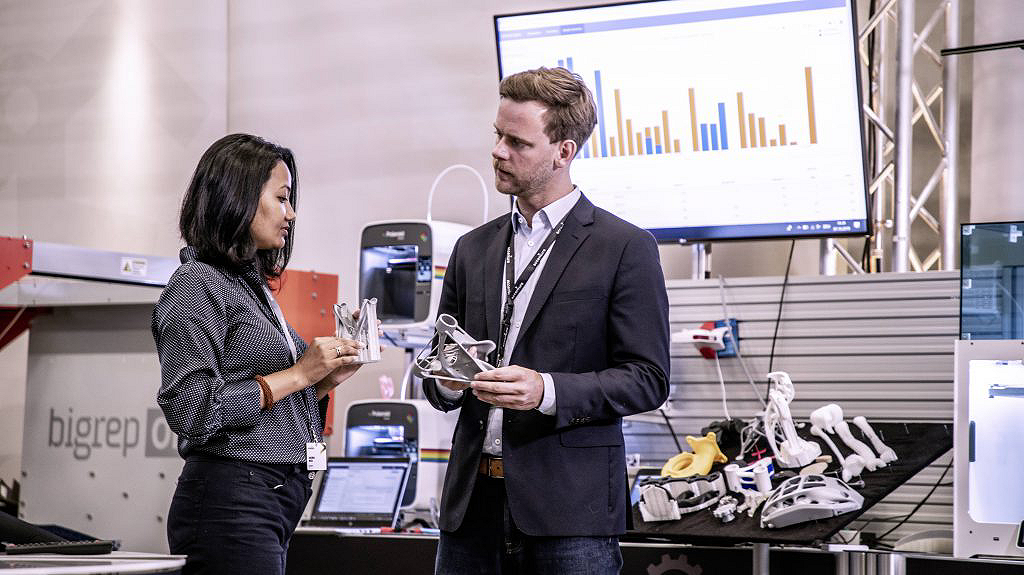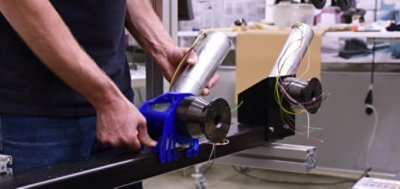Blog
How AI-driven generative design transforms engineering
5-MINUTE READ
May 28, 2020
Blog
5-MINUTE READ
May 28, 2020
Nowadays, artificial intelligence and machine learning algorithms power everything from spam filters to autonomous vehicles. Engineering companies have turned to these algorithms to assist with the engineering design process and to create highly optimized products. Early adopters not only experience shorter design cycles, but also unlock greater potential, which disrupts the whole engineering and digitization product lifecycle.
By Dr. Felix Wunner, Tino Krüger, and Bernd Gierse


Generative design and digital additive manufacturing play a key role at the Accenture Industry X Innovation Center in Garching. | Image: Accenture
Let's take a look at where the conventional engineering design process falls short and how generative design can exceed traditions. Let's consider some real-world examples in action to understand why many engineers have turned to artificial intelligence (AI) and machine learning (ML) algorithms to assist with the design process.
Traditional engineering design processes have been applied for hundreds of years for everything from furniture to rockets. A tried-and-true process has been responsible for countless engineering marvels throughout history.
The engineering design process typically goes something like this:
This represents a quite linear process, and there are a few significant drawbacks to this approach:
Conventional engineering design software has helped to address some of these issues. Despite automatic calculations and faster design capabilities than pen-and-paper, engineers still have to go through each development phase. That said, new technologies have the potential to amplify productivity in the same way they have across other industries. Generative design is a prime example of how digital means can increase efficiency among product development. This gives light to further optimization among value chains, specifically when introducing new manufacturing principles, such as 3D printing.
Generative design leverages artificial intelligence and machine learning to turn tedious engineering design processes into a sophisticated yet natural interaction between computer and engineer. The main part of the topology optimization and simulation is automatically conducted by the computing unit. Additionally, negative feedback loops are cut short by lowering the barriers to design. As a result, the engineer has more room to tackle challenges that require "common sense" or cannot be solved by computers.
Next-generation algorithms can be trained to not only optimize a design for specific engineering parameters, such as weight or durability, but also for commercial parameters, like production costs or even aesthetic requirements. Most interesting is its application to enhance functionality (by design) during use, such as considering heat flow through a component by nTopology. And if this wasn't enough, startups such as Additive Flow are developing applications that enable engineers to integrate different materials into one component while the application optimizes the topology in parallel. The result is often a superior product with a development time that’s much quicker than conventional design processes, something human brains struggle to achieve.
As mentioned before, generative design works best in conjunction with other technologies—generative design and 3D printing are a match made in heaven. First, 3D printing makes it possible to quickly prototype and test new designs without committing to a costly and time-consuming custom manufacturing run.
Second, and even more striking, there are no geometrical boundaries for a 3D printer. This means it can produce extremely complex structures that traditional methods, such as milling, are unable to manufacture.
Third, 3D printing facilitates mass-customization, i.e. it can print products tailored to single specific needs of the client. Imagine, an AI generates the most perfect part, just for your bike, and there is almost no economic drawback as it is produced only once.
Suppose you're designing a motorcycle swingarm. After coming up with a design area, connection points, and constraining parameters such as weight or torque, you spend hours calculating whether a proposed design would meet each of the engineering requirements—and that's just for a single proposed design!
In addition to saving time, generative design algorithms can also unlock entirely new products that weren’t possible before.
To understand the underlying magic and power of generative design, we must take a look at classic topology optimization algorithms. These have been around for decades and simply minimize designated objects according to its constraints, for instance volume or weight. Modern generative design algorithms utilize these steps and add a wider range of constraints. Now, the user can add now a greater variety of requirements. Hence, the workflow becomes larger and the AI analyses the application of different materials or even manufacturing principles. This ultimately makes engineering work easier and better!
In addition to saving time, generative design algorithms can also unlock new products that weren’t possible before. For example, researchers are using generative design algorithms to analyze a patient's bone structure and create customized orthopedic hardware on-the-spot using additive manufacturing processes.
General Motors became one of the first automotive companies to leverage generative design to reduce the weight of its vehicles. In 2018, the company worked with Autodesk engineers to create 150 new design ideas for a seat bracket and chose a final design that proved 40 percent lighter and 20 percent stronger than the original component.
Under Armour leveraged generative design algorithms to create a shoe with an optimal mix of flexibility and stability for all types of athletic training—inspired by tree roots. The algorithm came up with unconventional geometry that was 3D printed into a shoe and tested by more than 80 athletes in a fraction of the time that it would have taken in the past.
Phillipe Starck and Kartell used generative algorithms to combine aesthetic and function. The company asked a simple question: How can we rest our bodies using the least amount of material? The resulting collaboration between designer and AI yielded an unconventional but highly effective chair design.


Less material: Using generative algorithms combine aesthetic and function. This is a generative design example component from the autonomous driving vehicle project “free.da” project—in collaboration with designaffairs and Zielpuls and exhibited at the IIoT Innovation Center in Garching.
Generative design is a fast-evolving field and new stunning applications are created daily. Despite all that glitter, it is important to mention that generative design isn’t a simple no-brainer. Introducing generative design to your company or engineering department requires readiness and change among multiple stakeholders. It not only creates new products, but completely disrupts traditional structures. Consider the changes in the internal product lifecycle management (PLM) system when, for instance, simulation engineers or variant management becomes obsolete. Additionally, the challenge of ramping up engineers with generative design applications should not be underestimated. It is difficult to master the software and a larger learning curve must be considered—it‘s not a plug-and-play application.
Many popular engineering design applications already support generative design powered by artificial intelligence. For example, Autodesk has brought generative design out of the lab with integration into its products. There is also a growing number of open source standalone projects that provide generative design capabilities.
Accenture leverages generative design to assist clients in building the best products and practices. The company’s product engineering services enables organizations to “shift left” and accelerate their research and development efforts, as well as reduce their R&D costs, accelerate time-to-market, and drive increased agility. Specialists help to integrate generative design applications and software to existing PLM processes.
Generative design is a powerful new way to approach engineering design problems. While AI and ML can't replace humans (yet), they can automate many of the tedious processes that create bottlenecks, ranging from optimization to aesthetics. Many of these capabilities are already present in modern tooling.